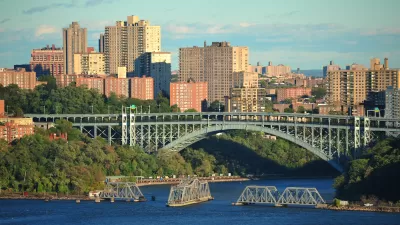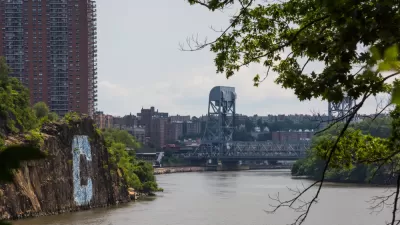Traditionally immigrant neighborhoods in the northernmost reaches of Manhattan, Washington Heights and Inwood are seeing new, white collar companies set up shop in the low-rent neighborhoods.
"According to the latest census data, the number of white-collar jobs in sectors likes information technology, finance, management, and other professional and scientific areas in Washington Heights and Inwood has doubled from 10,173 in 2000 to 20,038 in 2010.
The total number of jobs in the neighborhoods has also risen 31 percent since 2000, though the population has remained almost constant, registering a tiny dip from 208,414 to 208, 215. The unemployment rate for the neighborhoods is still significantly more than the city average of 9 percent, but has declined from 14.3 percent to 13.5 percent since 2000, at a time when it is increasing elsewhere."
FULL STORY: Washington Heights Sees White-Collar Boom

Alabama: Trump Terminates Settlements for Black Communities Harmed By Raw Sewage
Trump deemed the landmark civil rights agreement “illegal DEI and environmental justice policy.”

Planetizen Federal Action Tracker
A weekly monitor of how Trump’s orders and actions are impacting planners and planning in America.

Why Should We Subsidize Public Transportation?
Many public transit agencies face financial stress due to rising costs, declining fare revenue, and declining subsidies. Transit advocates must provide a strong business case for increasing public transit funding.

Judge Orders Release of Frozen IRA, IIJA Funding
The decision is a victory for environmental groups who charged that freezing funds for critical infrastructure and disaster response programs caused “real and irreparable harm” to communities.

‘Clybourne Park’ Sets Stage for Housing Equity Discussions
Clybourne Park, a play exploring race, real estate, and community tensions, can set the stage for discussion on the lasting impacts of housing discrimination, gentrification, and the fight for affordability.

Understanding Road Diets
An explainer from Momentum highlights the advantages of reducing vehicle lanes in favor of more bike, transit, and pedestrian infrastructure.
Urban Design for Planners 1: Software Tools
This six-course series explores essential urban design concepts using open source software and equips planners with the tools they need to participate fully in the urban design process.
Planning for Universal Design
Learn the tools for implementing Universal Design in planning regulations.
Caltrans
Smith Gee Studio
Institute for Housing and Urban Development Studies (IHS)
City of Grandview
Harvard GSD Executive Education
Toledo-Lucas County Plan Commissions
Salt Lake City
NYU Wagner Graduate School of Public Service




























